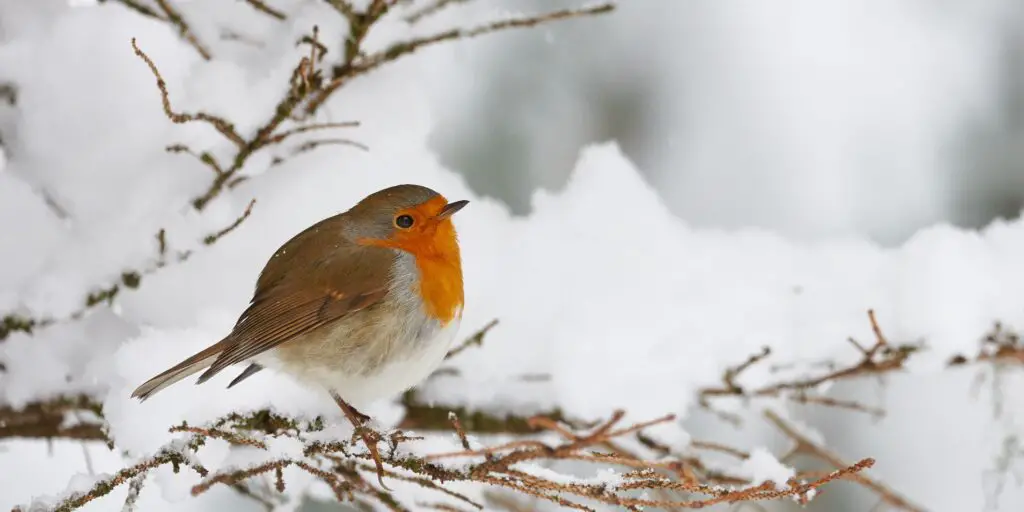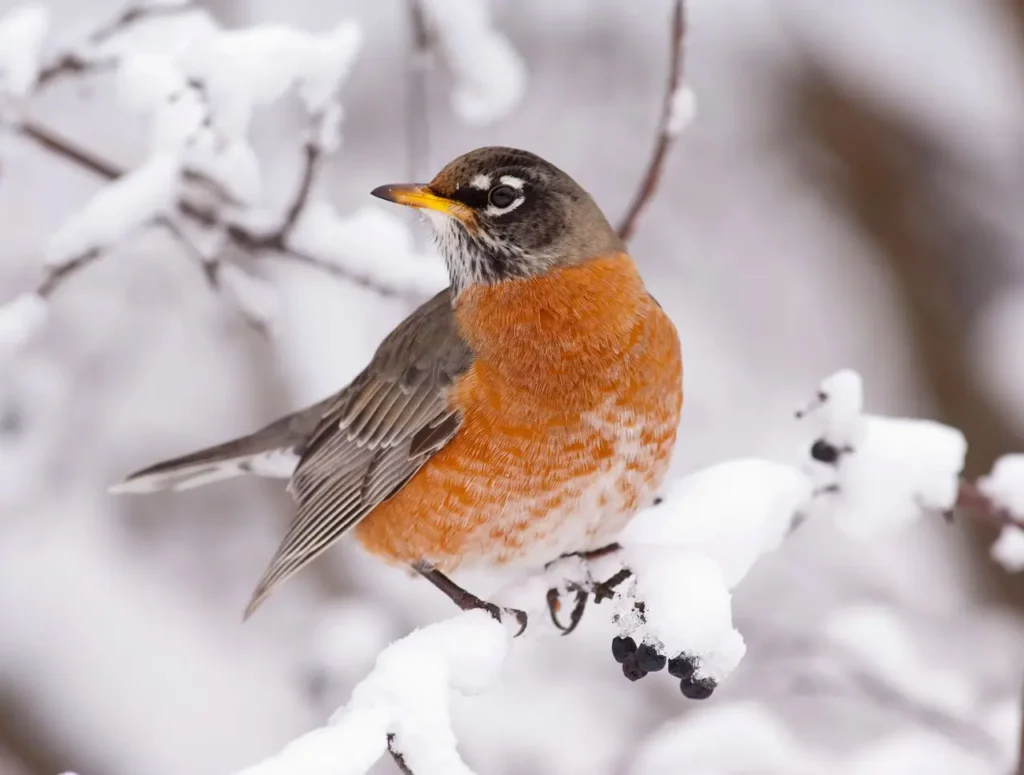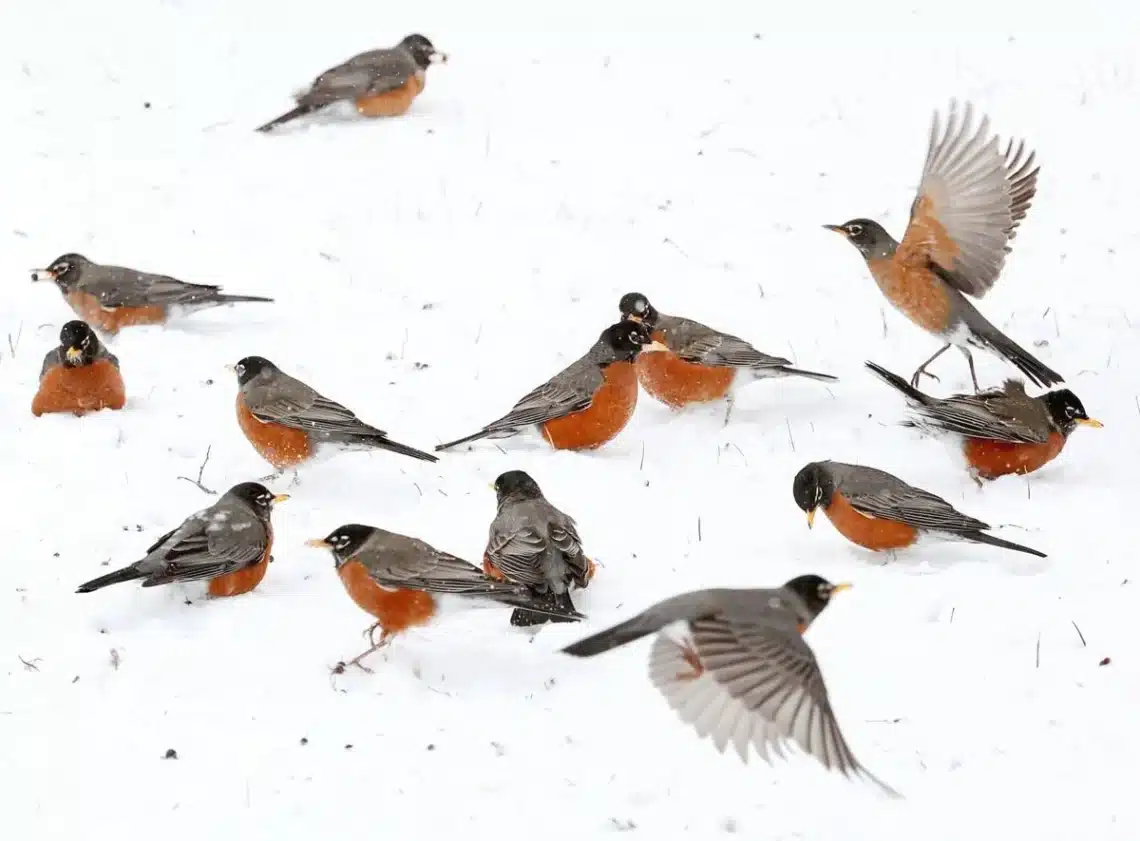Introduction
Where Do Robins Go In The Winter: During the colder months, as the days grow shorter and temperatures drop, American robins engage in a fascinating transformation. The bird that once graced our gardens with its songs and feasted on earthworms begins a migratory journey that takes it far from its familiar breeding grounds. While we associate robins with the arrival of spring, their winter whereabouts are a captivating mystery for many.
As autumn’s colors paint the landscape, robins start to gather in flocks, signaling the beginning of their seasonal migration. These gatherings are a prelude to their departure from the regions where they raised their young during the summer. They are now in search of warmer climes, where food is more readily available and the harsh winter conditions are less severe.
Robins are not just one-size-fits-all when it comes to winter destinations. Some stay in milder regions within their breeding territory, while others embark on a remarkable southward journey. These migratory flocks can cover vast distances, crossing state lines and even international borders in pursuit of more hospitable winter habitats.

Do all robins go south for the winter?
Yep! All robins are not the same: The vast majority of robins do move south in the winter. However, some stick around — and move around — in northern locations.
While many American robins do indeed migrate south for the winter, all robins follow this migratory pattern. The winter habits of robins can vary depending on several factors, including their geographic location, local climate, and food availability.
Partial Migration
In regions with milder winters, such as parts of the southern United States, Mexico, and the Pacific Coast, some American robins may choose to stay year-round. These individuals find enough food sources, including berries and insects, to sustain themselves throughout the winter months.
Resident Robins
In suburban and urban areas where food is often more readily available due to human landscaping and supplemental feeding, robins may also remain in place during the winter. These resident robins have adapted to local conditions that provide them with sustenance.
Northern Migrations
On the other hand, in regions with harsher winters and reduced food resources, many robins migrate southward in search of more favorable conditions. This southward migration can take them to various destinations, including the southern United States, Mexico, and Central America.
Spring Return
Regardless of their winter choices, most American robins return to their breeding grounds in North America as spring approaches. Their arrival is often heralded as a sign of the changing seasons and the impending arrival of warmer weather.
Do robins mate in winter?
American robins breed in the spring shortly after returning from their winter range. The breeding season extends from April through July.
Robins, like many bird species, have a specific breeding season tied to the arrival of spring and warmer temperatures. While they may engage in courtship behaviors during winter, their actual mating and egg-laying typically occur in the spring and early summer.
Winter Courtship
During the winter months, robins may engage in courtship rituals as they establish and maintain pair bonds. These behaviors include singing, chasing, and displaying to attract potential mates. These courtship interactions serve to strengthen the bonds between individuals, laying the foundation for future breeding.
Spring Breeding Season
As the days grow longer and temperatures rise in the spring, robins shift their focus to breeding. This is when the actual mating occurs. Male robins often sing from prominent perches to establish territory and attract females. Once pairs are formed, they engage in mating, and females subsequently lay eggs in well-constructed nests.
Nest Building and Incubation
After mating and egg-laying, robins diligently engage in nest building and incubation, with both parents sharing the responsibilities. This stage of parenting is essential for the successful development of their offspring.
Raising Chicks
Robins continue to care for their young throughout the summer, feeding them a diet rich in insects and worms. Once their chicks fledge, or leave the nest, robins may go on to raise additional broods, contributing to the survival and growth of their species.
Is A robin a winter bird?
The Robin is only really seen in winter and because of this, it has become a staple of Christmas cards and decorations.
The American robin is a bird with a dual identity when it comes to the seasons. While it is most famously associated with the arrival of spring and the heralding of warmer weather, it is not solely a winter or summer bird. Rather, the behavior of robins varies with the changing seasons, and their presence can be observed year-round, depending on geographic location and individual behavior.
Spring and Summer
Harbingers of Spring:** Robins are renowned as the quintessential sign of spring’s arrival. In many regions of North America, they are among the first birds to return from their winter migrations. Their melodious songs and vibrant orange-red breasts are welcomed symbols of the changing seasons, marking the end of winter’s chill and the beginning of spring’s renewal.
Winter
Migration and Resident Populations:** While robins are strongly associated with spring, not all of them migrate south for the winter. In milder regions, such as parts of the southern United States and along the Pacific Coast, some robins may choose to remain resident throughout the year, finding suitable food sources to sustain them in the winter.
Migration Patterns
In regions with harsher winters, many robins do embark on southward migrations in search of more favorable conditions and food sources. These migrations can take them to destinations in the southern United States, Mexico, and even Central America.
Which bird comes in winter?
Some birds such as Pintail Ducks, Curlews, Flamingos, Ospreys and Little Stints migrate to our country in the winter season every year. Kingfishers and Comb Ducks migrate to India in the summer season and the rainy season respectively.
The winter months bring a variety of bird species to different regions, each adapted to the challenges and opportunities presented by the cold season. Here are some notable birds that are often associated with winter:
American Robins
While known for their springtime arrival, many American robins migrate south during the winter. However, some remain in milder regions, and their presence can be a sign of the changing seasons.
Dark-Eyed Juncos
These small, slate-gray sparrows are commonly seen in North America during the winter months, where they forage for seeds on the ground and at bird feeders.
Northern Cardinals
With their striking red plumage, northern cardinals brighten winter landscapes across North America. They are known for their year-round presence but are particularly visible against snowy backgrounds in winter.
Black-Capped Chickadees
These small, lively birds are known for their distinctive “chick-a-dee-dee-dee” call. They stay active throughout the winter and can be spotted at feeders.
European Robins
In Europe, the European robin is a common winter visitor, known for its red-orange breast. It is a year-round resident in many regions but becomes more visible in gardens and parks during the colder months.
Snow Buntings
These birds are adapted to cold climates and are often seen in snowy, open areas during winter. Their white plumage provides excellent camouflage in snowy environments.
Waterfowl
Many species of ducks, geese, and swans migrate to warmer areas during the winter, making lakes, rivers, and coastal regions popular wintering grounds for waterfowl.
What do Robins go to in the winter?
In winter, robins share the edge of huge Red-winged Blackbird roosts with Common Grackles and starlings and feed with Cedar Waxwings. The southern races in the eastern United States and in Mexico do not migrate. Occasionally, when berries are abundant, a few hardy robins winter in Quebec, Ontario, and the prairies.
As winter casts its icy spell on North America, American robins embark on a remarkable journey in search of more hospitable surroundings. While they are best known for their cheerful songs and vibrant presence in spring and summer, robins’ winter destinations reveal a different side of their adaptable nature.
Southward Migration
The majority of American robins residing in colder regions of North America undertake a southward migration as winter approaches. Their winter destinations can span a wide range, from the southern United States to Mexico and even Central America. These migratory journeys can cover hundreds or even thousands of miles.
Preferred Winter Habitats
Robins are not limited to one type of winter habitat. They can be found in woodlands, suburban areas, farmlands, and open fields. The availability of food sources, such as fruits and berries, influences their choice of winter habitat.
Resident Populations
In milder regions, some robins choose not to migrate and remain resident throughout the year. These individuals have adapted to local conditions that provide them with sustenance during the winter months.
Return of Spring
Regardless of their winter choices, most robins return to their breeding grounds in North America with the arrival of spring. Their joyful songs and diligent nest building are celebrated signs of the changing seasons, marking the end of winter’s reign.
Why do robins appear in winter?
In winter UK Robin ventures out to investigate other robins’ areas. Winter is when Robins look for mates, when you hear robins singing in winter, it is their mating call. Mating can start as early as autumn and doesn’t end until spring so don’t be surprised if you see a Robin well into spring.
While American robins are most famously associated with the arrival of spring and the onset of warmer weather, it may surprise many to see them during the winter months in some regions. Several factors contribute to the presence of robins during winter:
Partial Migration
In regions with milder winters, some American robins may choose not to migrate south. Instead, they remain resident throughout the year, finding enough food sources to sustain them in these more temperate climates. This behavior is particularly common along the West Coast of the United States and in parts of the southern U.S.
Food Availability
Robins are primarily insectivorous during the breeding season, but in winter, their diet shifts to berries and fruits. In areas where berry-bearing shrubs and trees provide a year-round food source, robins are more likely to stay during the colder months.
Varied Winter Habitats
Robins are adaptable birds and can be found in various winter habitats, including woodlands, suburban areas, and farmlands. Their presence in winter often depends on the availability of these habitats and the food sources within them.
Regional Behavior
The presence of robins in winter varies regionally. In some parts of their range, such as the Northeastern United States, it’s less common to see robins during winter, as many migrate south. However, in regions like the Pacific Northwest, seeing robins year-round is more typical.
Why are robins so fat in the winter?
To keep warm while roosting, birds fluff their feathers. Because of the way their feathers are layered, this behavior traps pockets of warm air next to the skin. During winter days, many birds feed almost continually, storing up fat that they burn off at night to keep warm.
The plump appearance of robins during winter is not a sign of excess indulgence but rather a strategic adaptation for their survival in cold weather. Several factors contribute to the apparent “fatness” of robins in winter:
Energy Reserves
Robins need substantial energy to endure the harsh conditions of winter, which can include freezing temperatures and reduced food availability. By building up fat reserves in the autumn, they have a vital energy source to draw upon during the leaner months of winter. Fat serves as an efficient fuel for maintaining their body temperature and staying active when food is scarce.
Food Scarcity
Insects, which make up a significant part of the robin’s summer diet, become less available in winter. Robins switch to a diet rich in fruits and berries during this season. To digest these foods efficiently, they need a well-insulated body to maintain a sufficiently high body temperature.
Insulation
Fat also serves as insulation against the cold. A layer of subcutaneous fat helps conserve body heat and prevents heat loss in the chilly winter environment.
Migration Preparation
For those robins that migrate, building up fat reserves is essential for the energy-intensive journey south. The fat provides fuel for their migratory flights, ensuring they have the stamina to complete the journey successfully.
Do robins have babies in the winter?
Robins are one of the earliest birds to nest and can begin building as early as January if the weather is mild, although the breeding season usually begins in March. They start laying their eggs between mid-April and mid-August, with baby chicks fledging after around two weeks.
Robins are renowned for their dedicated parenting during the spring and summer months when they build nests, lay eggs, and raise their young. However, it is exceedingly rare for robins to have babies in the winter, and the typical breeding season for robins occurs during the warmer seasons of spring and early summer. Here are some reasons why winter nesting in robins is uncommon:
Unfavorable Conditions
Winter is a challenging time for bird reproduction due to harsh weather conditions, limited food sources, and reduced daylight hours. These factors make it difficult for young birds to survive and thrive.
Breeding Season Timing
Robins are photoperiodic, which means their breeding behavior is strongly influenced by the length of daylight. They typically initiate breeding activities when days are longer and temperatures are milder, signaling the arrival of spring. This ensures that young robins have a higher chance of survival when food is more abundant and weather conditions are less severe.
Food Availability
Insects, a primary food source for robin chicks, are less abundant in the winter, making it challenging to provide sufficient nourishment for the young birds.
Nesting Habits
Robins often build new nests for each brood they raise. The act of constructing a nest and finding a suitable location for it is a complex process that requires time and effort. During the winter, these nesting behaviors are not typically observed.

Conclusion
The winter journey of American robins unveils a captivating tale of adaptation and survival in the face of changing seasons. As these beloved birds leave their familiar breeding grounds, they embark on migrations that take them to a variety of winter destinations, where they seek refuge from the cold and find nourishment among the available fruits and berries.
Their resilience and adaptability shine through as they make the most of diverse habitats, from woodlands to suburban areas, all while enduring the challenges of long-distance travel. Yet, the return of robins in the spring serves as a heartwarming reminder of the cyclical nature life and the rejuvenation of the natural world.
The winter migration of robins is a testament to the remarkable journeys that many bird species undertake to ensure their survival. It is a story that underscores the importance of preserving and protecting the habitats that these birds rely on during their seasonal wanderings. Eagerly anticipate the return of robins and the promise of spring, let us cherish the beauty of their migrations and the wonders of the changing seasons in the tapestry of our natural world.





No Comments